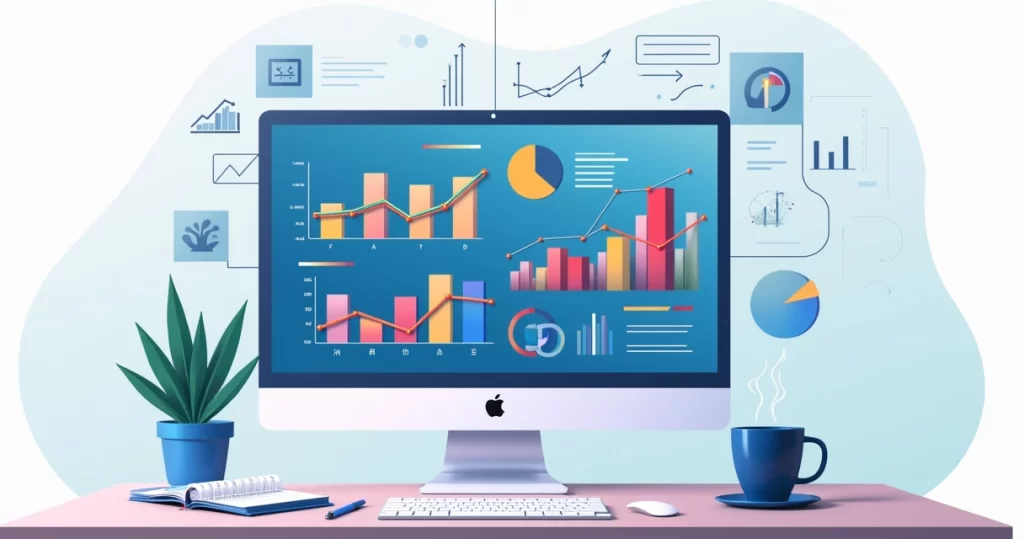There is a certain moment when every business person, manager, or start-up founder runs into a wall of data. It might arrive in the form of spreadsheets, sales reports, website analytics, or even scattered notes from day-to-day operation. For many, that’s when a business dashboard for beginners becomes not just helpful—but essential. Suddenly, all this data starts turning into noise. Day after day, you wish for a simple way to see what’s truly happening—without getting lost deciding what matters, what doesn’t, or just looking at another colorless grid.
That’s usually the moment when dashboards begin to make sense. But what exactly is a business dashboard for beginners? Why do so many people keep talking about them as if they’ll save the day? And if you have only basic experience with Excel or Power BI, where do you even start?
This guide is here to help you understand, see the bigger picture, and, if things go well, feel a little less overwhelmed when you hear the word “dashboard.” Along the way, you’ll notice some references to LucasSanroma.com, which is a project dedicated to making business dashboards and data visualization much more practical, human, and even a little beautiful— especially for those who feel lost at first.
What is a business dashboard?
You might think of dashboards as fancy, interactive charts, but let’s take a step back. Imagine driving a car. Would you do it without a dashboard? Not for long, probably. In business, dashboards are your “car dashboard”—except instead of speed and fuel, you see sales, costs, website visitors, and more. They collect your key numbers and display them in a clear, usually visual way.
A dashboard is a window into the health of your business.
Some dashboards are live. Others show a snapshot. Some look visually stunning; others are painfully simple, yet effective. What matters is getting the right information in front of you, in a way you can actually act on.
Why dashboards help beginners (and pretty much everyone)
When you’re new to using data for decision-making, dashboards can feel intimidating. But, to be honest, they exist mostly to make your life easier, not harder.
- They reduce information overload.
- They show what’s working and what’s not, at a glance.
- They help different people in the company speak the same language (numbers).
- They often highlight hidden trends or surprises—sometimes the kind you miss when inspecting data line by line.
I remember working with a small marketing startup. They tracked every ad click and prospect, constantly sending themselves spreadsheets. But nobody could see the whole story. Their crisis came when the founders argued about “what’s going wrong?” A single dashboard, with a few core metrics and basic charts, ended the confusion—and the arguments.
Common dashboard types
All dashboards show data, but the question is: which data, for whom, and how often? The answer usually leads to different categories. You don’t have to remember them all, but understanding the main ones helps you ask the right questions.
1. Operational dashboards
These are “real-time” dashboards, showing what’s happening right now, or as close as possible. Think of call center screens showing agents on duty or online store dashboards with today’s sales and support tickets. Operations teams use these to stay alert and act fast.
2. Tactical dashboards
The line is blurry, but these are usually aimed at team leads. They combine operational details (“How many tickets are open?”) and bigger trends (“Is this week better than last?”) to help teams make everyday decisions.
3. Analytical dashboards
When you want to investigate trends, dig into why something happened, or compare months and years, these dashboards go deeper. Lots of charts. Filters. Patterns over time. Great for analysis—less for fast action.
4. Strategic dashboards
These help managers and executives see progress toward goals: growth, market share, profit, customer satisfaction—often month to month or quarter to quarter. Less noise, more focus.
What should a good dashboard include?
Maybe this is the hardest part, because everyone has opinions. Still, people at LucasSanroma.com believe that a good dashboard, especially for beginners, usually includes these elements:
- Clear headings and timeframes. Is it today, this month, or last year’s numbers?
- A few core indicators (KPIs). Not dozens—just the ones that matter for your goals.
- Easy-to-read visuals. Bar charts, gauges, trends—not overly detailed, not hidden in jargon.
- Some context. If you see “42%,” is that good, bad, or average?
- Space to spot patterns—arrows showing up or down, color changes.
One thing I often regret is why so many people cram as much as possible into a dashboard. Too much, too soon, and nobody wants to look at it. Maybe you’ve seen that, too? The best dashboards are sometimes the simplest.

What are KPIs, anyway?
The word “KPI” gets thrown around a lot in dashboard conversations. It stands for Key Performance Indicator. In plain language, it’s a single number or value that tells you if an area of your business is healthy—or not.
Examples:
- Sales per month
- Website conversion rate
- Number of customer support tickets closed each day
- Churn rate (how many customers left last month)
Choosing KPIs, actually, is trickier than it sounds. If you pick too many, you lose focus. If you choose the wrong ones, you might chase numbers that don’t actually help your business.
A dashboard is only as helpful as the clarity of its KPIs.
That’s one area where LucasSanroma.com offers guides and templates—helping you avoid common mistakes, and making KPI selection less confusing.
Dashboards are more than just charts
If you think a dashboard is just a bunch of charts, you’re missing out. Some include explanations, targets, notes, or even alerts if something important changes. A dashboard isn’t only about “seeing more”—it’s about seeing what matters, when it matters.
Let’s try a practical tip: open any dashboard and ask, “What decision can I make now, based on this?” If there’s no clear answer, then either the data is wrong, or the way it’s displayed doesn’t help. Either way, it needs fixing.

When to create a dashboard, and when not to
Some people think dashboards are always useful. Not entirely true. Sometimes, you just need a quick number and can skip building a dashboard. Other times, especially when teams need to meet and discuss business performance regularly, a dashboard saves hours (and arguments).
Ask yourself:
- Do I keep checking the same numbers every day, week, or month?
- Is it hard to explain how things are going, unless I show people the data?
- Does my team argue about “what’s really happening”?
If the answer to these is “yes,” then you probably can benefit from a good dashboard.
Still, if nothing needs tracking over time, or if the data barely changes, maybe you’re fine without one—at least for now.
Key terms you’ll hear with dashboards
If you read up on dashboards, you’ll run across technical words. Here are a few—along with explanations that might sound more human:
- Metric: One number that measures something: sales, visitors, calls, etc.
- Visualization: A way to turn data inIf you read up on dashboards, you’ll run across technical words. Here are a few—along with explanations that might sound more human:
- to something you can “see”—like a chart or a map.
- Data source: Where the dashboard gets its numbers from—like a database, website, or even an Excel sheet.
- Filter: Lets you pick what to look at: “Show me only this month,” or “only for New York customers.”
- Drill-down: Clicking on something in the dashboard to get more details.
- Trend: A pattern over time—is the number going up, down, or staying flat?
LucasSanroma.com has glossaries and beginner guides that break down dashboard jargon, so you can skip the headache.
Dashboards: benefits and possible issues
Of course, dashboards aren’t magic. They help in lots of ways, especially once you decide what’s really worth tracking, but sometimes things go wrong.
Benefits
- Everyone sees the same numbers. Fewer meetings about “why the spreadsheet looks different.”
- Faster decisions—especially with live data.
- Surprises stand out. If something weird happens, a dashboard can show it quickly.
- You save time. Once running, dashboards often replace dozens of manual reports.
Possible issues
- Wrong data leads to wrong conclusions. Accuracy matters.
- Too many charts confuse people. Keep it simple at the start.
- Design matters. Ugly, cluttered dashboards get ignored.
- Sometimes, dashboards show numbers, but not the “why.” You still might need meetings or research.
I once consulted a business where the dashboard looked like a Christmas tree—so many blinking things, people just stopped looking. It took a month to simplify it. Afterward, more people actually checked it. Makes you think, doesn’t it?
Choosing your dashboard tool: Excel, Power BI, and beyond
The tool you use makes a difference, but not as much as you might think. Many beginners start with Excel—it’s familiar, flexible, and cheap (sometimes free). Others try Power BI, Google Data Studio, or more “out of the box” platforms if they want better visuals or easier sharing.
- Excel: Great for small businesses, fast changes, and when you like control.
- Power BI: Better suited for large datasets, automation, and real-time dashboards. It’s a powerful tool by Microsoft, though the learning curve can be a bit steep for beginners.
- Looker Studio (formerly Google Data Studio): A free, web-based option great for collaborative reports and simple dashboards online—especially if your data already lives in Google Sheets.
- Other tools: There’s a tool for every need—some look gorgeous, others work on any device. Budget, team size, and comfort with tech matter a lot.
LucasSanroma.com actually specializes in templates and guides for both Excel and Power BI, with a special interest in beginners who want clarity without a headache.
Don’t get stuck searching for the “perfect” tool. Pick one you understand, start small, and grow from there.
Making your first dashboard: a simple path
There are lots of ways to start, but maybe this order works for most:
- Choose your main question. “How are sales performing?” or “Are support tickets getting closed faster?”
- Pick 3-5 metrics. Any more and it gets unclear. Fewer, and you might miss things.
- Decide how often to update. Daily, weekly, monthly? Don’t aim for “real-time” unless you really need it.
- Choose your tool. Excel is usually easiest to begin with. If it’s ugly or confusing, try template sites like LucasSanroma.com.
- Sketch, then build. Draw your dashboard on paper first. Save hours of rework.
- Add data, make charts, show only what matters. Remove the rest.
- Ask someone else to check if it’s clear. If they get confused, tweak it.
Along the way, don’t fall into the trap of “waiting until it’s perfect.” Even imperfect dashboards are better than endless spreadsheets.

How to keep improving
Dashboards aren’t “set it and forget it.” People change, questions change, and businesses change. What made sense last year might make no sense tomorrow. If someone says, “I never look at that dashboard,” find out why, and don’t be afraid to change things.
Try asking your team, “Which number on this dashboard would you want to know today?” Their answer will tell you what really matters.
Think of your dashboard as a living document, not a static one. Tweak, update, clean up. Remove what’s not working.
Great dashboards evolve with your goals.
And of course, resources like LucasSanroma.com are there with new templates, guides, and tips whenever you feel stuck—or inspired to build something a little better.
Final thoughts: your business, your dashboard
No two businesses are identical. The “best” dashboard is the one you and your team understand, look at, and use. Sometimes it’s colorful, sometimes plain. But always, the best dashboards are the ones that help you see what matters, make decisions, and get a little peace of mind when the numbers arrive.
If you’ve ever felt lost staring at numbers, or unsure which data matters most, you’re not alone. Simple steps, small beginnings, and learning as you go—these are the ingredients for successful dashboards.
If you want to make data something you feel confident about, or if you’re hunting for templates, inspiration, or real-world dashboard examples, take a look at LucasSanroma.com. Discover new ways to take control of your numbers, understand your business, and turn all that data into decisions. Start your dashboard story today—sometimes, that’s all it takes for everything to click.
Free Download: Your First Excel Dashboard Template
If you made it this far, you’re probably ready to take the first step. So here’s a little gift to help you begin your dashboard journey today:
👉 Download the Free Excel Dashboard Template
Just open it, add your data, and see your numbers come to life.
This beginner-friendly Excel template includes:
- A clean layout for up to 5 KPIs
- Pre-built charts you can easily customize
- Sections for context, goals, and trends
- Clear headings and simple visuals
Whether you’re tracking sales, support tickets, or website traffic, this template helps you get started without the overwhelm.


